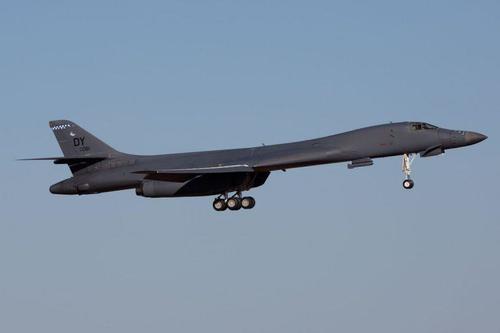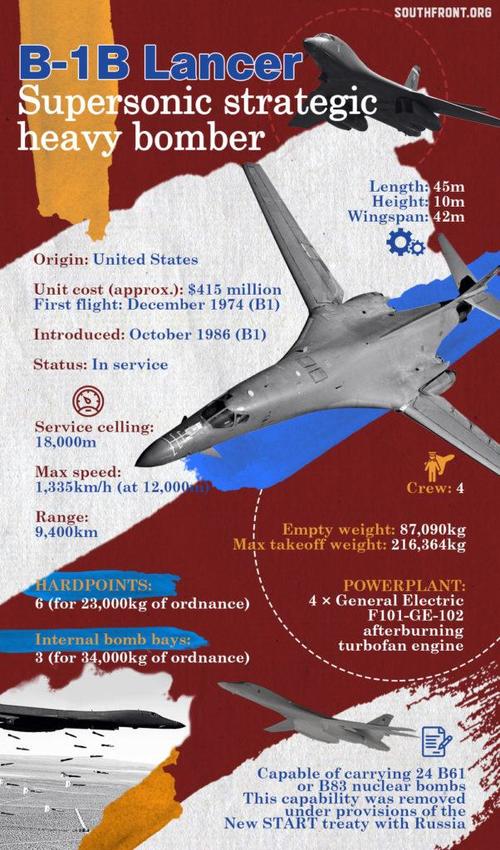U.S. To Deploy B1-B Lancer Strategic Bombers To Norway For Arctic Contention
Submitted by Southfront.org
In 2021, the United States and its allies’ focus has shifted heavily towards the Arctic. The Arctic region was dubbed as the next battlefield of various interests, but the situation was only rhetorically tense, for a while.
According to Scramble, the US Air Force is planning a Bomber Task Force (BTF) deployment, with four Rockwell B-1B Lancers, to Ørland (Norway) in February 2021.
The date of arrival is not yet clear, but is said to be somewhere late in week 7 or early in week 8. This means end of February.
Ørland Main Air Station (hovedflystasjon) is situated at the mouth of the Trondheimsfjorden in the municipality of Ørland, in Trøndelag county, in the centre of Norway.
The air base has a 2,714 metres (8,904 feet) runway, oriented north-west to south-east (15/33) and a ramp with four parking spots for large aircraft.
The air station is the home of 332 skvadron, operating the F-35A Lightning II. Also, a detachment of 330 skv with the Sea King Mk43B is based at this air station.
This is a rare occurrence, since US strategic bombers typically operate out of the UK, but with focus shifting on the Arctic, the closer proximity will play a significant role.
Back in September 2020, B-1B Lancers assigned to the 345th Expeditionary Bomb Squadron conducted training with the Norwegian air force.
The 16-hour sortie that crossed directly over the North Pole as part of a Bomber Task Force mission here.
The 6,100 nautical mile mission received air refueling support over the Arctic Ocean before spending several hours training with the Norwegian forces off the coast of Greenland and over the Norwegian Sea. It highlighted the U.S. Air Force’s capacity to conduct complex operations in multiple areas of responsibility with NATO allies and partners.
Col. Christopher Hawn, 345th EBS commander, said the ability to operate in the Arctic region is important in supporting U.S. European Command (EUCOM) initiatives and in fulfilling the objectives of the 2018 National Defense Strategy, which reoriented the U.S. military’s focus from the Middle East to near-peer concerns in Asia and Europe.
“It is about access,” he explained. “In a near-peer conflict, the closest point of access could require us to go through the Arctic, so we need to ensure we are well versed in that operational environment.”
Operating out of Eielson Air Force Base proved to be an invaluable training opportunity for the unit, whose home station is Dyess AFB, Texas.
“The fact that we can conduct operations at a moment’s notice from Alaska to anywhere within the EUCOM area of responsibility sends a strong message,” said Lt. Col. Andrew Marshall, 345th EBS director of operations.
Training in the Arctic has grown increasingly important, as the region holds strategic value for U.S. Air and Space Forces as well as its allies and partners. It is also vital to homeland security, as it provides avenues of approach to the U.S. from space, air, sea, and land.
“The harsh conditions and limited access throughout the region make it easy to overlook the value of the Arctic,” Marshall said. “However, the increase in global competition for access and control of the region solidifies the Arctic’s status as a key territory.”
The situation in the Arctic promises to become hotter as time goes by, it should be reminded that recently it was revealed that Russia was working on floating airfields to be used in the arctic, and it is also constructing an airfield in the region.
https://ift.tt/3ccAEfa
from ZeroHedge News https://ift.tt/3ccAEfa
via IFTTT






0 comments
Post a Comment